GIS > Appearance > Render Settings (select from Main Menu)
![]() Render Settings (click icon on GIS Layer Manager Bar or select from Right-click Menu)
Render Settings (click icon on GIS Layer Manager Bar or select from Right-click Menu)
Open Render Settings box.
This function opens the Render Settings box in which render settings for the currently selected GIS layer can be set. The Render Settings box has the following tabs (for changing the input layouts):
Layout: Style
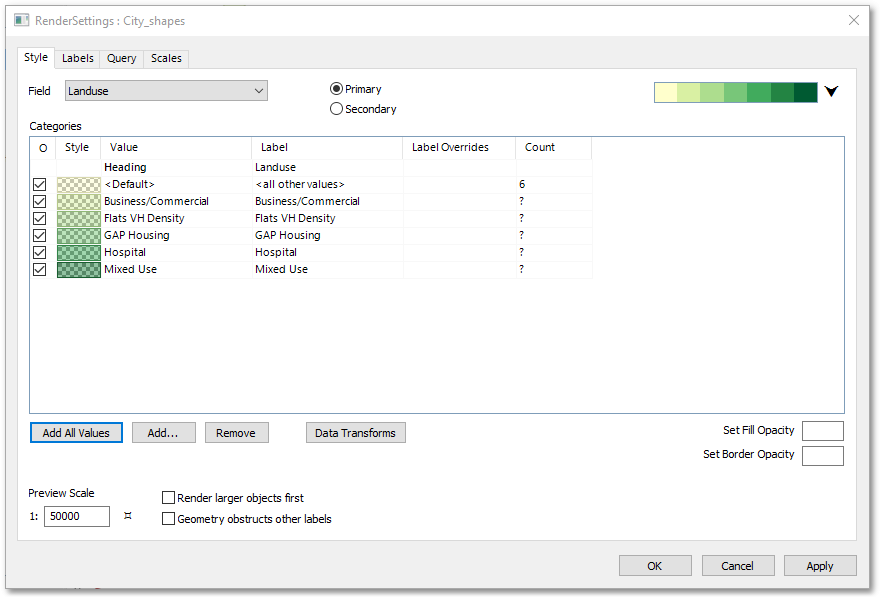
- Field
The currently active field on which on which the rendering will be based, on can be selected from the Field drop-down list. See example screen-shot above, where the Landuse field has been selected from the Field drop-down list.
- Palette
The Palette drop-down arrow can be clicked to open the Palette control.
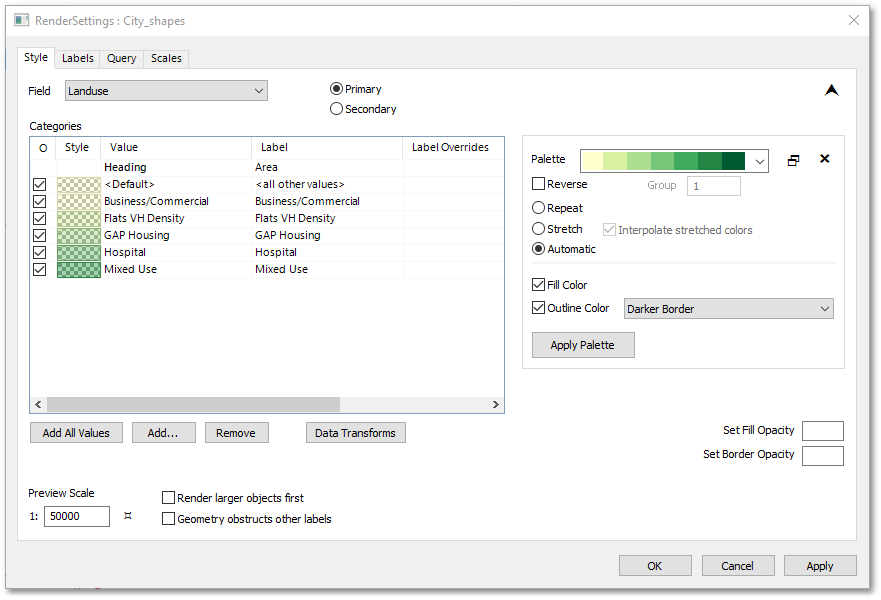
The Palette control has many settings, such as:
• Fill Color tick box (when unticked Palette fill colours will not be applied)
•Outline Color tick box (to apply outlines colours or not)
•Drop-down list to select the border darkness
•Palette colours can set by clicking the ![]() icon, which will open the Color Palette box:
icon, which will open the Color Palette box:
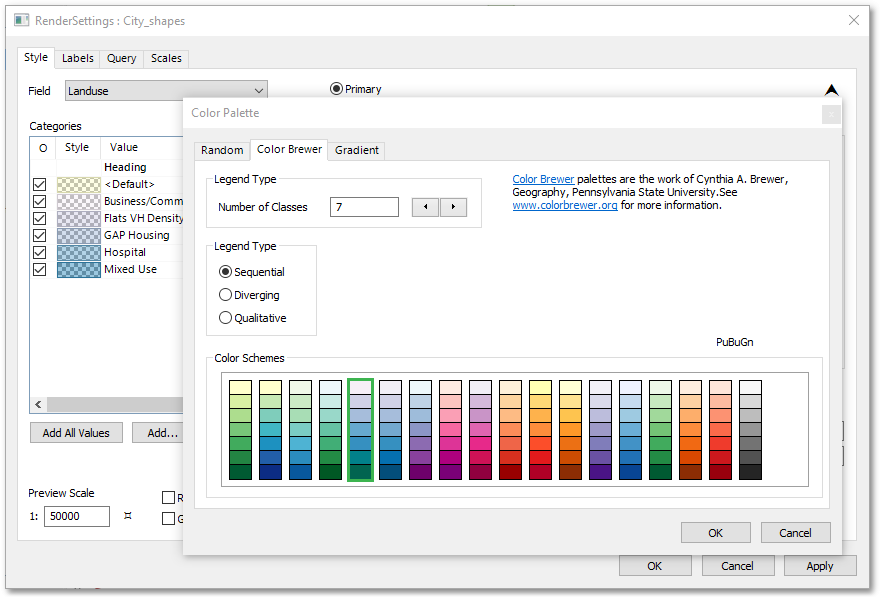
The above Color Brewer classification schema (developed by Cynthia A. Brewer) is the default option. The Number of Classes can be specified to change the number of vertical colour blocks. The Legend Type has the following colour ramping options: Sequential , Diverging and Qualitative. The first (default) option is Sequential, which provides a gradual transition from light to darker colours.
Random and Gradient are other colour classification schemas that can be accessed from the Color Palette box, which will result in different colour ramping effects.
Note, if colour ramping is not applicable to your data such as for landuse categorization, then you can simply click on the colour palettes in the render settings box to open the Pick Style box and change the colour of the individual categories (as described in the Quick Start Guide).
- Add All Values
The Add All Values button can be clicked to automatically generate categories for all unique values of the currently selected field. See example screen-shot above, where categories have been generated for the Landuse field.
- Add...
The Add... button opens the following sub-meu where most of the style category functions can be accessed:
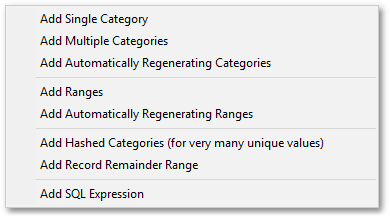
•Add Single Category: One or more categories can be added manually via the Add Manual Categories box:
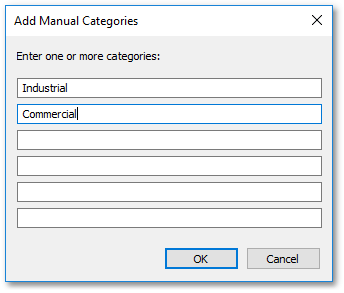
•Add Multiple Categories: Multiple Categories can be added by selecting them from the Pick Categories to Add box:
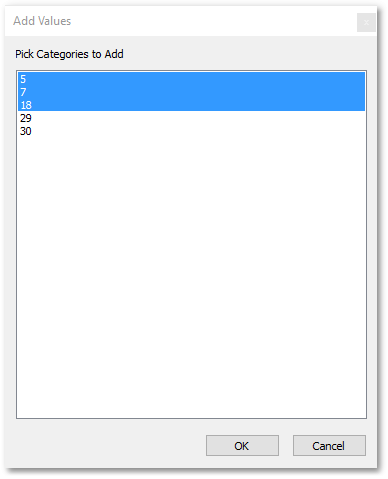
Note, all unique values of the currently selected field are automatically displayed in the above box (and are selectable).
•Add Automatically Regenerating Categories: This menu item has the same function as the Add All Values button, viz. automatically generate categories for all unique values of the currently selected field.
•Add Ranges: The Add Ranges menu item opens the Define Range box. From the Define Range box, you can set up the Resulting Categories to focus only on a specific range by specifying High and Low values. Alternatively, click the Get Database Limits button to define the full data range. The number of divisions values must be entered to specify the number of categories to generate. The example below shows a range between 0 and 10 with 5 categories in increments of 2:
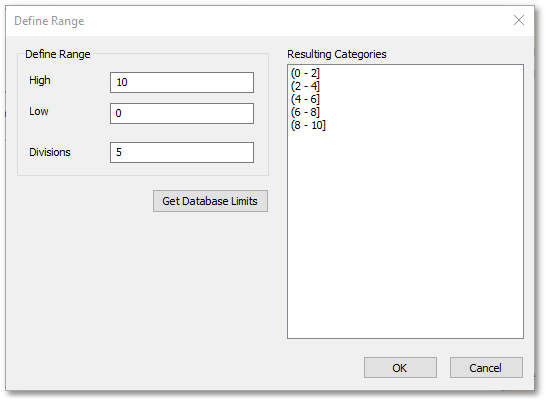
•Add Automatically Regenerating Ranges: This menu item opens the Minimum number of categories box, in which the minimum number of categories for the automatic category generation can be specified. If Exact category count is not ticked, then more categories may be generated to obtain better category breaks.
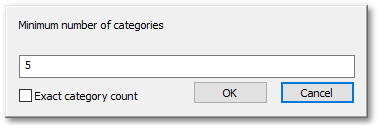
•Add Hashed Categories (for very many unique values): You will be prompted for the number of uniquely coloured hashed categories to add to the Render Settings box (to be used in subsequent categorization).
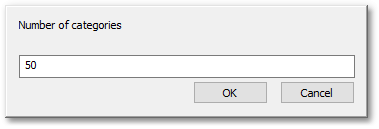
Add Record Remainder Range: You will receive the same prompt as above, but in this case Record Remainder catergories will be added. These are useful to indicate entities that were not rendered previously. The Render Settings box will be updated the following: Value field will receive incremental values starting with one, and the the Label field will be labeled with 'Record Remainder X (where X will also be incremented by each record remainder added).
•Add SQL Expression: Opens the Script box in which an SQL Script can be entered to defined a custom search criteria for values to be contained in a category.
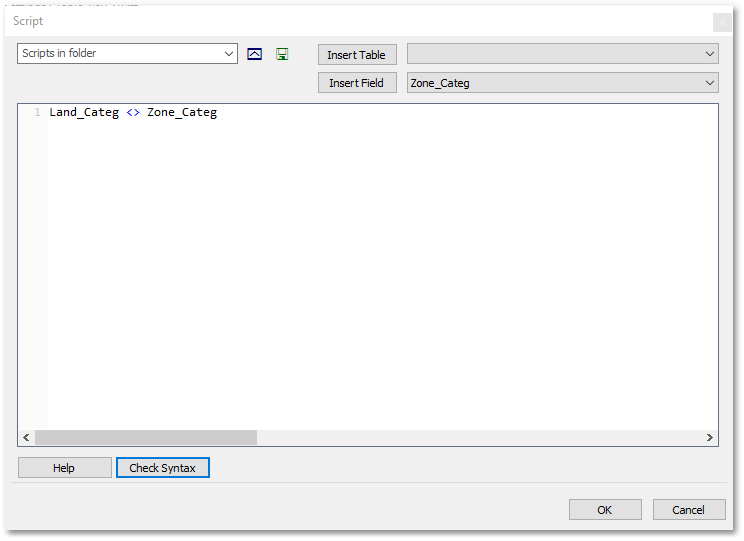
The Render Settings box will automatically be updated with the following: The SQL query expression will be added to the Value field and the phrase 'Expression' will be inserted in the Label field. The latter, can afterwards be edited with a custom description.
- Remove
The Remove button removes a selected category. A category to be removed, can be selected by clicking on or dragging over the 'Value' column. Note, you cannot delete the <Default> or the header categories.
- Data Transforms
Options on Case Sensitivity, Absolute Value and Numeric Tolerance can be specified here. These options will affect the cutoff margins for Single categories and Range categories, they do not affect SQL-based categories.
- Set Fill Opacity
Set opacity of all selected fill colours. A value for opacity can be entered in the white input box ranging from 0 (completely transparent) to 100 (completely opaque).
- Set Border Opacity
Set opacity of all selected borders. A value for border opacity can be entered in the white input box ranging from 0 (completely transparent) to 100 (completely opaque).
Layout: Labels

- Draw Labes
The Draw Labels tick box can be ticked to display the labels in the spatial environment (as configured in the Render Settings box). When unticked, the labels will not be displayed.
- Text
•Labels from Field: Labels can be placed based on textual information contained in field values. The field can be selected from a drop-down list (see above, where the field Landuse is e.g. selected).
•Labels from Script: Labels can be placed via a Lua Script. The Script box can be opened by clicking on the ![]() Script icon (see above screen-shot) in which the Lua Script can be entered. Scripts can also be selected from the drop-down list next to the
Script icon (see above screen-shot) in which the Lua Script can be entered. Scripts can also be selected from the drop-down list next to the ![]() Script icon. For example the script shown below, labels parcels with the phrase "flag" when their AADD = 4 kl/day. The Check Syntax button can be clicked to check the syntax of the specified query, and obtain correction suggestions if the syntax was faulty.
Script icon. For example the script shown below, labels parcels with the phrase "flag" when their AADD = 4 kl/day. The Check Syntax button can be clicked to check the syntax of the specified query, and obtain correction suggestions if the syntax was faulty.
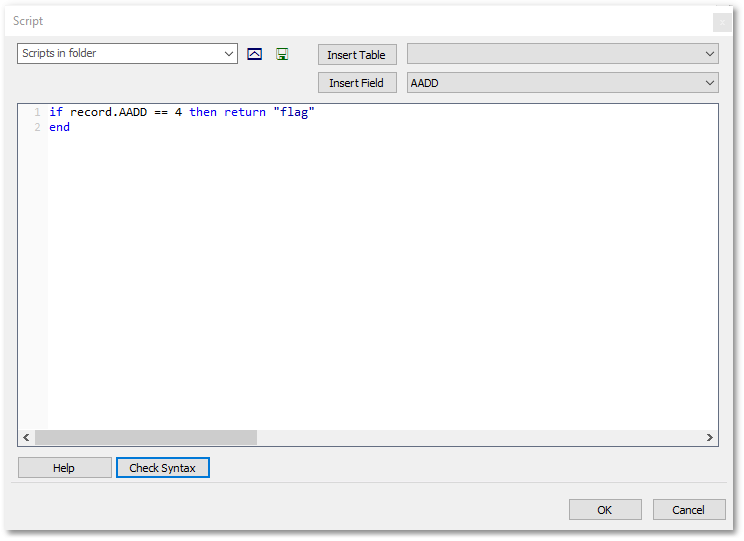
•Labels from Categorization: Labels can be placed according to the Label text specified for the Categories (as discussed above for the Render Settings: Style box).
- Format
Numeric Format: The numeric format of the labels can be selected from the Numeric Format drop-down list. This list is only enabled when you specify a numeric field from the above described Labels from Field drop-down list.
- Style
•Text Height: The text height of the labels can be set from Text Height drop-down list. You must first select from the list the units (default is true world units, such as meters) and then enter in the field the height. The other units that can be specified from the list are: points (1/72 inch on paper), vmm (screen millimetres) and px (screen pixels).
•Text Font: The text font of the labels can be selected from Text Font drop-down list. The standard fonts that can be selected from the list are: Arial and Segoe UI. Other fonts can, however, be specified by selecting the Add new style/font... from the list which will open the Font box where various Fonts, Font style, Size and Script can be selected. The latter changes the character sets to comply with other language regions such as Western, Hebrew Arabic, Greek, etc.
•Text Color: The text color of the labels can be selected from the Color box, which opens when clicking on the RGBA button. The Get From Entity tick box can be ticked, to inherent the colour from the colour of the underlying rendered entity (which the label is associated with).
•Text Outline Color: The text outline color of the labels can be selected from the Color box, which opens when clicking on the RGBA button, located just below the RGBA button for Text Color (described above).
- Rotation
•Angle from Field: The labels can be rotated based on the field values contained in a specified 'rotation' field. This field can be selected from the adjacent drop-down list.
•From Geometry: The labels can be rotated based on the underlying geometry (which the label is associated with). If the underlying geometry is a polyline, then a tick box will be enabled which can be ticked to specify that the label placement and rotation should be based on the longest line segment instead of the the middle segment.
•Fixed: The labels are rotated based on a specified fixed degrees value.
- Text Layer
•Unique Layer: The labels can be placed on a separate new layer by entering the name of the new layer in the adjacent drop-down list box or simply accept the default name.
•Geometry Layer: The labels can be placed on the same layer as the underlying geometric entity (which the label is associated with).
- Position
•Alignment: The label alignment can be specified by clicking on the interactive graphic (a purple box will highlight to indicate the label placement relative to the orange centre point).
•Horizontal Offset and Vertical Offset: Can be specified in metres.
•Multi-line horizontal alignment: When labels stretch over more than one line, their horizontal alignment can be set via clicking on interactive graphic (lines of text will highlight accordingly).
- Intelligence
•Just place labels: Labels will simply be placed without any intelligent placement strategy.
•Use Intelligent Placement: Click the Configure button to open the Intelligent Label Placement box. TheIntelligent Label Placement box has the following tabs (for changing the input layouts):
Layout: Placement Options
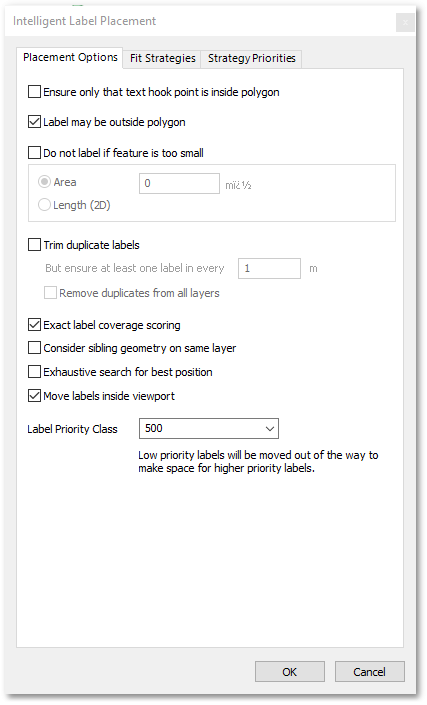
oEnsure only that text hook point is inside polygon: This ensures that the labels are inside polygons. If unticked, then the option below will become enabled.
oLabel may be outside polygon: Can be ticked to allow labels to appear outside polygons.
oDo not label if feature is too small: A minimum Area or Length can be specified.
oTrim duplicate labels: Optimum spacing between labels can be set, and it can be specified to remove duplicates from all layers.
oMove labels inside viewport: This allows labels to extend into viewport areas.
oLabel Priority Class: A Label Priority Class value can be assigned to the labels of the current layer, between 1000 (Highest) and 0 (Lowest). The median class is 500 (Default). Low priority labels will be moved out of the way to make space for high priority labels.
Layout: Fit Strategy
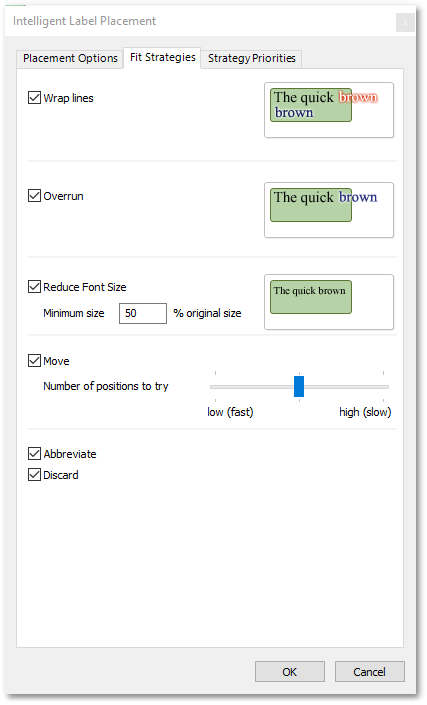
oWrap lines: When ticked, allows for the text of labels to wrap over to the next line(s) in order to fit in.
oOverrun: Allows text to overshoot when they not fit in.
oReduce Font Size: When Reduce Font Size is allowed, you can specify the minimum size in percentage of the original size a font may be reduced.
oMove: When text moving is allowed, you can specify (for the label placement algorithm) the number of positions to try by shifting the grahical ruler between low (fast) and high (slow). Basically a tradeoff between processing speed and label quality.
oAbbreviate: Allows for labels to be abbreviated in order to fit in.
oDiscard: Specifies if a label may be removed when there is no ideal fitting.
Layout: Strategy Priority
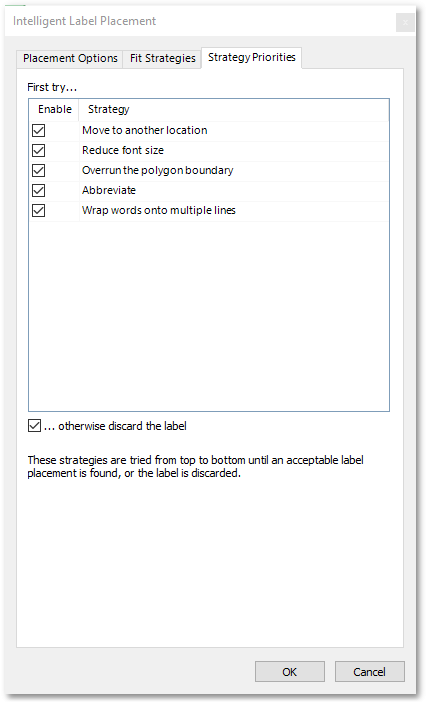
The above Strategy Priority box is a (priority) list box where you can click and and drag strategy items up or down in the hierarchy. Strategies are tried from top to bottom until an acceptable label placement is found, or the label is discard (if label Discard is enabled). Note, you can either enable/disable the strategies by clicking the tick boxes on this input layout page, or on the Fit Strategies layout page as already discussed . The two input pages are interconnected, i.e. edits made on the one page will automatically be reflected on the other.
Layout: Query
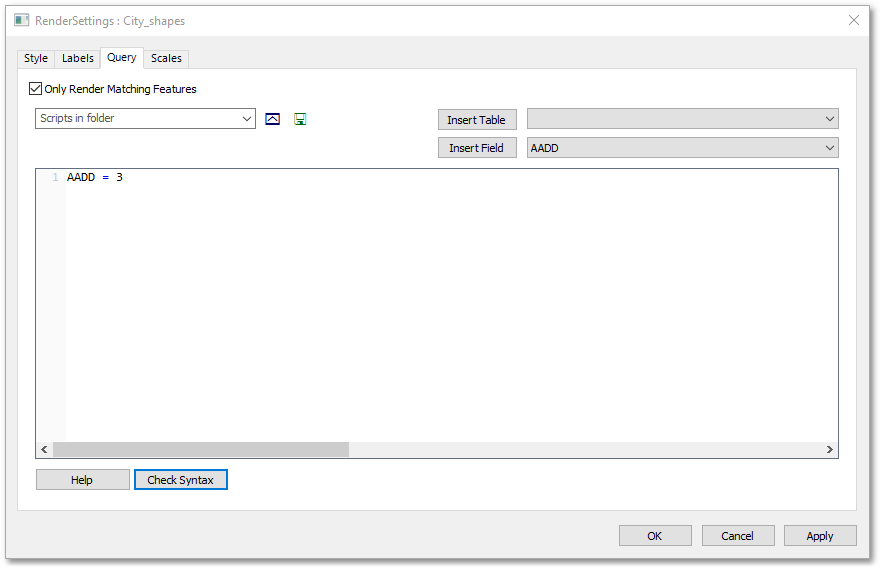
- Only Render Matching Features
The Only Render Matching Features tick box can be ticked to only render features in the spatial environment (as configured in the Render Settings box) that match an SQL query as defined in the above SQL query box. The non-matching features will then not be rendered and will not be displayed. When unticked, however, all features will be displayed regardless of the query outcome. For example the script shown above, will render only parcels with AADD = 3 kl/day. The Check Syntax button can be clicked to check the syntax of the specified SQL query, and obtain correction suggestions if the syntax is incorrect.
Layout: Scale
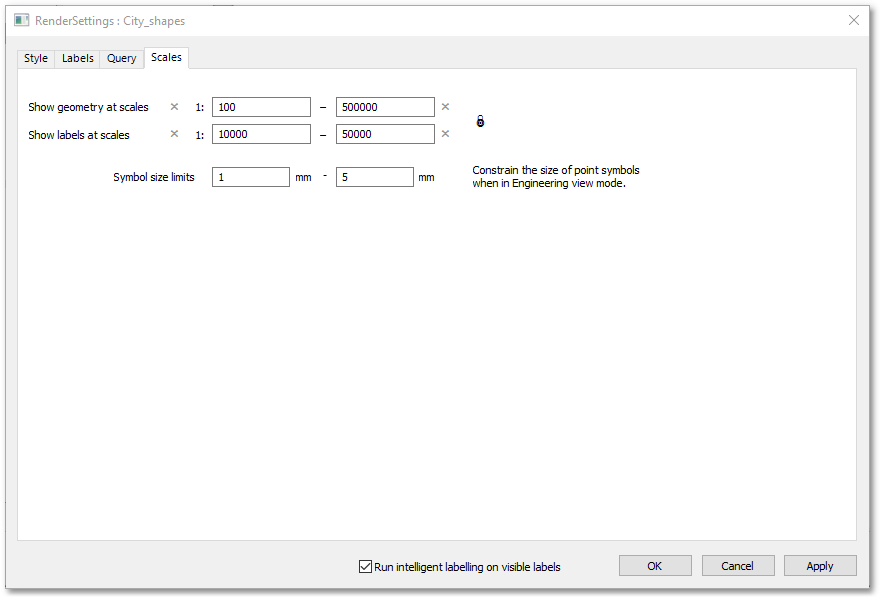
The allowable scales for drawing geometric entities and labels and the symbol size (mm) range for drawing point symbol can be specified as shown in the example above. This will prevent the drawing get cluttered when zooming in too much and to prevent details showing when zooming out too far. Note, to get the Show labels at scales input boxes enabled (for inputting scales) click on the ![]() Scale Lock icon.
Scale Lock icon.